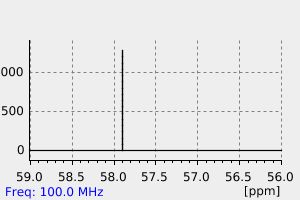四甲基铵 | 51-92-3
中文名称
四甲基铵
中文别名
——
英文名称
tetramethylammonium
英文别名
tetramethylammonium cation;tetramethylammonium ion;TMA;tetramethylazanium
CAS
51-92-3
化学式
C4H12N
mdl
——
分子量
74.146
InChiKey
QEMXHQIAXOOASZ-UHFFFAOYSA-N
BEILSTEIN
——
EINECS
——
-
物化性质
-
计算性质
-
ADMET
-
安全信息
-
SDS
-
制备方法与用途
-
上下游信息
-
文献信息
-
表征谱图
-
同类化合物
-
相关功能分类
-
相关结构分类
计算性质
-
辛醇/水分配系数(LogP):0.3
-
重原子数:5
-
可旋转键数:0
-
环数:0.0
-
sp3杂化的碳原子比例:1.0
-
拓扑面积:0
-
氢给体数:0
-
氢受体数:0
SDS
反应信息
-
作为反应物:参考文献:名称:Characterization and Fate of N-Nitrosodimethylamine Precursors in Municipal Wastewater Treatment Plants摘要:The potent carcinogen, N-nitrosodimethylamine (NDMA), is produced during disinfection of municipal wastewater effluent from the reaction of monochloramine and organic nitrogen-containing precursors. To delineate the sources and fate of NDMA precursors during municipal wastewater treatment, NDMA formation was measured after extended chloramination of both model precursors and samples from conventional and advanced wastewater treatment plants. Of the model precursors, only dimethylamine, tertiary amines with dimethylamine functional groups, and dimethylamides formed significant NDMA concentrations upon chloramination. In samples from municipal wastewater treatment plants, dissolved NDMA precursors always were present in primary and secondary effluents. Biological treatment effectively removed the known NDMA precursor dimethylamine, lowering its concentration to levels that could not produce significant quantities of NDMA upon chlorine disinfection. However, biological treatment was less effective at removing other dissolved NDMA precursors, even after extended biological treatment. Significant concentrations of particle-associated NDMA precursors only were detected in secondary effluent at treatment plants that recycled water from sludge thickening operations in which dimethylamine-based synthetic polymers were used. Effective strategies for the prevention of NDMA formation during wastewater chlorination include ammonia removal by nitrification to preclude chloramine formation during chlorine disinfection, elimination of dimethylamine-based polymers, and use of filtration and reverse osmosis to remove particle-associated precursors and dissolved precursors, respectively.DOI:10.1021/es035025n
-
作为产物:参考文献:名称:压力跳跃法研究4A型沸石中甲基铵离子与钠(1+)的离子交换动力学摘要:DOI:10.1021/j150625a037
-
作为试剂:参考文献:名称:Alkyl aryl bromophosphates : nouveaux reactifs de phosphorylation摘要:DOI:10.1016/s0040-4039(00)71487-0
文献信息
-
Zum ?Hofmann'schen Abbau? des Gelsemins作者:V. Prelog、J. B. Patrick、B. WitkopDOI:10.1002/hlca.19520350231日期:1952.2.1Die durch die thermische Spaltung aus quaternären Ammonium-Basen von Gelsemin und seinen Hydrierungsprodukten erhaltenen des-N-Methyl-Basen5) erwiesen sich als identisch mit den entsprechenden N(a)-Methyl-gelsemin-Derivaten.
-
Quaternary Ammonium Trifluoromethoxide Salts as Stable Sources of Nucleophilic OCF<sub>3</sub>作者:Josiah J. Newton、Benson J. Jelier、Michael Meanwell、Rainer E. Martin、Robert Britton、Chadron M. FriesenDOI:10.1021/acs.orglett.0c00099日期:2020.3.6methyl ethers provides quaternary ammonium trifluoromethoxide (NR4OCF3) and pentafluoroethoxide (NR4OCF2CF3) salts, respectively, in good yields. The new trifluoromethoxide salts disclosed herein are uniquely stable for extended periods of time in both the solid state and in solution, which complements contemporary reagents. Here we describe the preparation of a range of NR4OCF3 salts, their long-term stability
-
Oxidation of elemental transition metals by decaborane to form metalloboranes
-
Synthesis and X-ray structure of [Ni<sub>16</sub>(CO)<sub>23</sub>C<sub>4</sub>]<sup>4–</sup>: a tetracarbide anionic cluster containing two interstitial C<sub>2</sub>fragments作者:Alessandro Ceriotti、Giuliano Longoni、Mario Manassero、Norberto Masciocchi、Giampiero Piro、Luigi Resconi、Mirella SansoniDOI:10.1039/c39850001402日期:——Reaction of [Ni10(CO)16C2]2â with four equivalents of PPh3 in tetrahydrofuran quantitatively afforded the novel brown [Ni16(CO)23C4]4â tetra-anion, whose metal frame has been shown by X-ray diffraction studies to consist of a unique hexadecanuclear truncated ν2-octahedron caging two interstitial C2 moieties with a very short interatomic C-C separation of 1.38 à .
-
Conformational Selection as the Mechanism of Guest Binding in a Flexible Supramolecular Host作者:Cynthia M. Hong、David M. Kaphan、Robert G. Bergman、Kenneth N. Raymond、F. Dean TosteDOI:10.1021/jacs.7b03812日期:2017.6.14initially self-assemble into an S4-symmetric structure and then subsequently isomerize to a T-symmetric tetrahedron for better accommodation of a sufficiently large guest. Selective inversion recovery 1H NMR studies provide structural insights into the self-exchange behaviors of the host and the guest individually in this dynamic system. Kinetic analysis of the encapsulation-isomerization event revealed that这项研究提供了对新型酶模拟金属配体宿主中宿主 - 客体封装行为的详细机制研究,并首次观察了超分子系统中的构象选择机制(与诱导匹配相反)。所描述的 Ga4L4 主体具有 C3 对称配体基序和间位取代的苯基间隔基团,这使主体能够最初自组装成 S4 对称结构,然后随后异构化为 T 对称四面体,以便更好地容纳足够大的来宾。选择性反转恢复 1H NMR 研究提供了对该动态系统中主体和客体的自交换行为的结构洞察。封装-异构化事件的动力学分析表明,增加客体浓度会抑制主客体松弛的速率,这是构象选择的一个关键区别特征。对这种简单酶模拟物的综合研究提供了对生物物理学和酶学中类似行为的深入了解,旨在为高效自组装微环境催化剂的设计提供信息。
表征谱图
-
氢谱1HNMR
-
质谱MS
-
碳谱13CNMR
-
红外IR
-
拉曼Raman
-
峰位数据
-
峰位匹配
-
表征信息
同类化合物
(乙腈)二氯镍(II)
(R)-(-)-α-甲基组胺二氢溴化物
(N-(2-甲基丙-2-烯-1-基)乙烷-1,2-二胺)
(4-(苄氧基)-2-(哌啶-1-基)吡啶咪丁-5-基)硼酸
(11-巯基十一烷基)-,,-三甲基溴化铵
鼠立死
鹿花菌素
鲸蜡醇硫酸酯DEA盐
鲸蜡硬脂基二甲基氯化铵
鲸蜡基胺氢氟酸盐
鲸蜡基二甲胺盐酸盐
高苯丙氨醇
高箱鲀毒素
高氯酸5-(二甲氨基)-1-({(E)-[4-(二甲氨基)苯基]甲亚基}氨基)-2-甲基吡啶正离子
高氯酸2-氯-1-({(E)-[4-(二甲氨基)苯基]甲亚基}氨基)-6-甲基吡啶正离子
高氯酸2-(丙烯酰基氧基)-N,N,N-三甲基乙铵
马诺地尔
马来酸氢十八烷酯
马来酸噻吗洛尔EP杂质C
马来酸噻吗洛尔
马来酸倍他司汀
顺式环己烷-1,3-二胺盐酸盐
顺式氯化锆二乙腈
顺式吡咯烷-3,4-二醇盐酸盐
顺式双(3-甲氧基丙腈)二氯铂(II)
顺式3,4-二氟吡咯烷盐酸盐
顺式1-甲基环丙烷1,2-二腈
顺式-二氯-反式-二乙酸-氨-环己胺合铂
顺式-二抗坏血酸(外消旋-1,2-二氨基环己烷)铂(II)水合物
顺式-N,2-二甲基环己胺
顺式-4-甲氧基-环己胺盐酸盐
顺式-4-环己烯-1.2-二胺
顺式-4-氨基-2,2,2-三氟乙酸环己酯
顺式-3-氨基环丁烷甲腈盐酸盐
顺式-2-羟基甲基-1-甲基-1-环己胺
顺式-2-甲基环己胺
顺式-2-(苯基氨基)环己醇
顺式-2-(苯基氨基)环己醇
顺式-2-(氨基甲基)-1-苯基环丙烷羧酸盐酸盐
顺式-1,3-二氨基环戊烷
顺式-1,2-环戊烷二胺二盐酸盐
顺式-1,2-环戊烷二胺
顺式-1,2-环丁腈
顺式-1,2-双氨甲基环己烷
顺式--N,N'-二甲基-1,2-环己二胺
顺式-(R,S)-1,2-二氨基环己烷铂硫酸盐
顺式-(2-氨基-环戊基)-甲醇
顺-2-戊烯腈
顺-1,3-环己烷二胺
顺-1,3-双(氨甲基)环己烷







